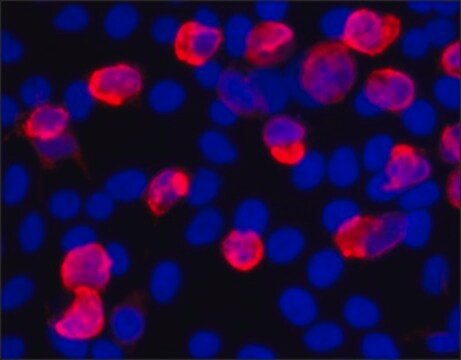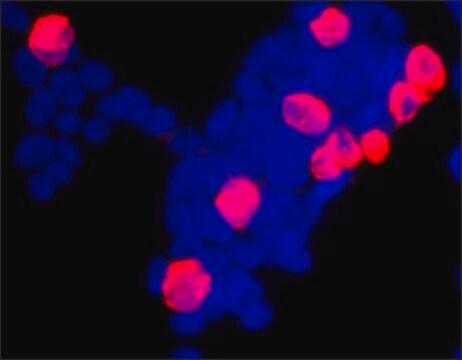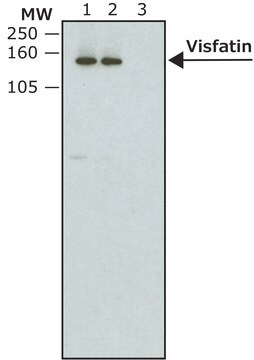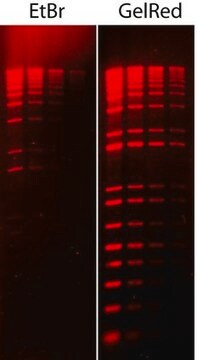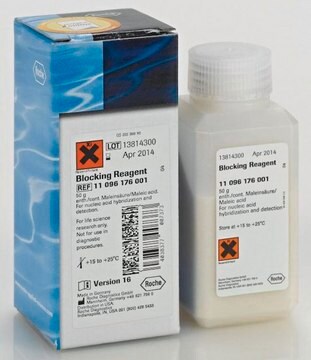V4014
Anti-V5-Cy3™ antibody, Mouse monoclonal
purified immunoglobulin, ~1 mg/mL, clone V5-10
Sinónimos:
Monoclonal Anti-V5
Iniciar sesiónpara Ver la Fijación de precios por contrato y de la organización
About This Item
Productos recomendados
biological source
mouse
Quality Level
conjugate
CY3 conjugate
antibody form
purified immunoglobulin
antibody product type
primary antibodies
clone
V5-10, monoclonal
concentration
~1 mg/mL
technique(s)
immunocytochemistry: 2.0-4.0 μg/mL
shipped in
wet ice
storage temp.
2-8°C
¿Está buscando productos similares? Visita Guía de comparación de productos
General description
Monoclonal Anti-V5 (mouse IgG1 isotype) is derived from the V5 hybridoma, produced by fusion of mouse myeloma cells and splenocytes from BALB/c mice immunized with a synthetic peptide corresponding to amino acid residues GKPIPNPLLGLDST (95-108) of the P/V proteins of the Paramyxovirus SV5, conjugated to KLH. The conjugate is then extensively dialyzed to remove unbound Cy3 fluorophore. Monoclonal Anti-V5, Cy3 conjugate recognizes the V5 tag sequence on V5 tagged fusion proteins by immunocytochemistry.
Specificity
Recognizes V5 Tag (GKPIPNPLLGLDST) fusion proteins
Application
Many recombinant proteins have been engineered to express a short sequence derived from the V5 molecule known as V5-tag. This tag facilitates the detection, isolation and purification of the proteins. Monoclonal antibodies reacting specifically with V5 and conjugated to Cy3 may be useful in various immunotechniques, and also to identify the expression of a V5 tagged fusion protein in situ by immunofluorescence.
Physical form
Solution in 0.01 M phosphate buffered saline, pH 7.4, containing 1% bovine serum albumin and 15 mM sodium azide.
Legal Information
Cy3 is a trademark of Cytiva
¿No encuentra el producto adecuado?
Pruebe nuestro Herramienta de selección de productos.
Storage Class
10 - Combustible liquids
wgk_germany
WGK 2
flash_point_f
Not applicable
flash_point_c
Not applicable
Elija entre una de las versiones más recientes:
¿Ya tiene este producto?
Encuentre la documentación para los productos que ha comprado recientemente en la Biblioteca de documentos.
Dharmendra K Singh et al.
Molecular plant-microbe interactions : MPMI, 27(1), 7-17 (2013-09-21)
Protein kinase-driven phosphorylation constitutes the core of cellular signaling. Kinase components of signal transduction pathways are often targeted for inactivation by pathogens. The study of kinases and immune signal transduction in the model crop tomato (Solanum lycopersicum) would benefit from
C Dunn et al.
Journal of immunological methods, 224(1-2), 141-150 (1999-06-05)
The monoclonal antibody (mAb) SV5-Pk is used widely in a variety of procedures to detect recombinant proteins tagged with the Pk tag, a 14 amino acid sequence derived from the P and V proteins of the paramyxovirus Simian Virus 5.
J A Southern et al.
The Journal of general virology, 72 ( Pt 7), 1551-1557 (1991-07-01)
Two canine isolates of simian virus 5 (SV5), termed CPI+ and CPI-, were examined for their ability to react with a bank of monoclonal antibodies (MAbs) that had been previously raised against a human isolate of SV5. CPI- virus was
S M Thomas et al.
Cell, 54(6), 891-902 (1988-09-09)
The "P" gene of the paramyxovirus SV5 encodes two known proteins, P (Mr approximately equal to 44,000) and V (Mr approximately equal to 24,000). The complete nucleotide sequence of the "P" gene has been obtained and is found to contain
Suena Ji et al.
Nature communications, 9(1), 3508-3508 (2018-08-31)
Regulated secretion is an essential process where molecules destined for export are directed to membranous secretory granules, where they undergo packaging and maturation. Here, we identify a gene (pgant9) that influences the structure and shape of secretory granules within the
Nuestro equipo de científicos tiene experiencia en todas las áreas de investigación: Ciencias de la vida, Ciencia de los materiales, Síntesis química, Cromatografía, Analítica y muchas otras.
Póngase en contacto con el Servicio técnico